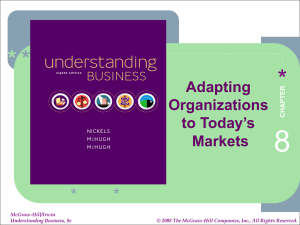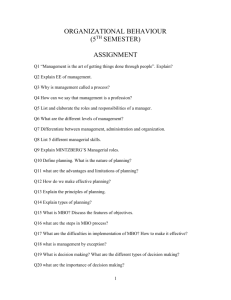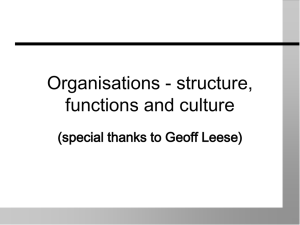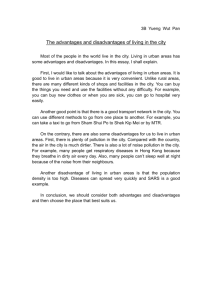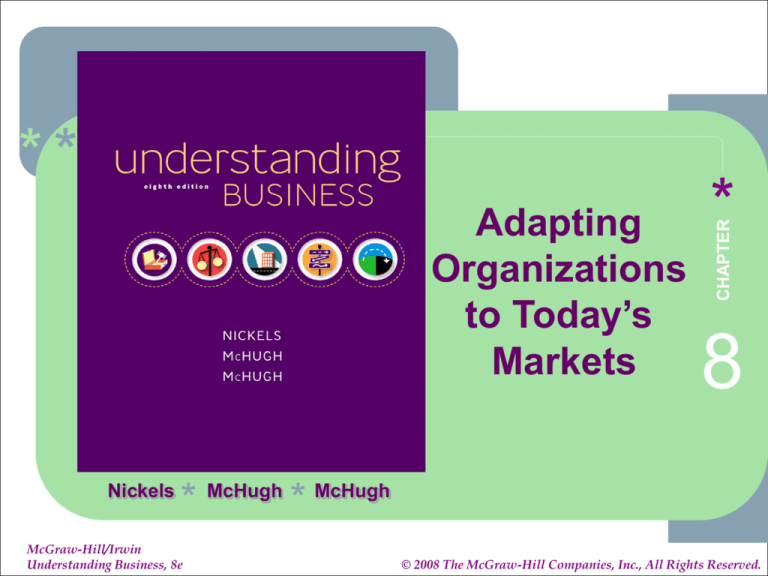
*
*
*
Adapting
Organizations
to Today’s
Markets
Nickels
*
McGraw-Hill/Irwin
Understanding Business, 8e
McHugh
*
*
CHAPTER
**
8
McHugh
1-1
8-1
© 2008 The McGraw-Hill Companies, Inc., All Rights Reserved.
*
*
*
Structuring an Organization
Comprises:
• Division of Labor
• Accountability
• Team Tasks
• Allocating
Resources
• Assigning
Responsibility/
Authority
• Establishing
Procedures
8-2
*
*
*
Fayol’s Principles
of Organization
• Unity of Command
• Hierarchy of
Authority
• Division of Labor
• Subordination of
Individual Interest
to the General
Interest
• Authority
• Degree of
Centralization
• Clear
Communication
Channels
• Order
• Equity
• Esprit de Corps
8-3
*
*
*
Weber’s
Organizational Principles
• Job Descriptions
• Written Rules
• Procedures, Regulations,
Policies
• Staffing/Promotions Based
on Qualifications
8-4
*
*
*
Centralization
(No Delegation)
Advantages
• Greater TopManagement Control
Disadvantages
• More Efficiency
• Less
Responsiveness to
Customers
• Simpler Distribution
System
• Less
Empowerment
• Stronger
Brand/Corporate
Image
• Interorganizational
Conflict
• Lower Morale Away
from Headquarters
8-5
*
*
*
Decentralization
(Delegate Authority)
Advantages
• Better Adaptation to •
Customer Wants
•
• More Empowerment
of Workers
•
• Faster Decision
Making
•
• Higher Morale
Disadvantages
Less Efficiency
Complex Distribution
System
Less Top-Management
Control
Weakened Corporate
Image
8-6
*
*
*
Organizational Structures
Tall Organizations
• Many Layers of
Management
• High Cost of
Management
• Narrow Span of
Control
Flat Organizations
• Current Trend
• Creation of Teams
• Broad Span of
Control
8-7
*
*
*
How to Make Jobs
Fit Your Company (Part 1 of 2)
Each manager must ask:
• What resources do I control to
accomplish my tasks?
• What measures will be used to evaluate
my performance?
• Who do I need to interact with and
influence to achieve my goals?
• How much support can I expect when I
reach out to others for help?
Source: HBS Working Knowledge, October 31,2005
8-8
*
*
*
How to Make Jobs
Fit Your Company (Part 2 of 2)
Four Basic Spans of a Job:
•
•
•
•
The Span of Control
The Span of Accountability
The Span of Influence
The Span of Support
Source: HBS Working Knowledge, October 31,2005
8-9
*
*
*
Span of Control - Narrow
Advantages
Disadvantages
• More Control by
Top Management
• Less Empowerment
• More Chances for
Advancement
• Greater
Specialization
• Closer Supervision
• Higher Costs
• Delayed Decision
Making
• Less
Responsiveness to
Customers
8-10
*
*
*
Span of Control - Broad
Advantages
• Reduced Costs
• More
Responsiveness
to Customers
• Faster Decision
Making
• More
Empowerment
Disadvantages
• Fewer Chances for
Advancement
• Overworked
Managers
• Loss of Control
• Less Management
Expertise
8-11
*
*
*
Departmentalization
by Function
Advantages
• Skill Development
• Economies of
Scale
• Good Coordination
Disadvantages
• Lack of
Communication
• Employees Identify
with Department
• Slow Response to
External Demands
• Narrow Specialists
• Groupthink
8-12
*
*
*
Departmentalization
• By Product
• By Function
• By Customer
Group
• By Geographic
Location
• By Process
8-13
*
*
*
Line Organizations
Advantages
• Clear Authority
& Responsibility
• Easy to
Understand
• One Supervisor
Per Employee
Disadvantages
• Inflexible
• Few Specialists
for Advice
• Long Line of
Communication
• Difficult to Handle
Complex
Decisions
8-14
*
*
*
Line/Staff Organizations
Line Personnel
Staff Personnel
• Formal Authority
• Advise Line
Personnel
• Make Policy
Decisions
• Assist Line
Personnel
8-15
*
*
*
Matrix Organizations
Advantages
Disadvantages
• Flexibility
• Costly/Complex
• Cooperation &
Teamwork
• Confusion in
Loyalty
• Creativity
• Requires Good
Interpersonal
Skills &
Cooperation
• More Efficient Use
of Resources
• Not Permanent
8-16
*
*
*
Important Conditions
for Small Teams
1.
2.
3.
4.
5.
Clear Purpose
Clear Goals
Correct Skills
Mutual Accountability
Shift Roles When Appropriate
Source: CIO Dec 2003
8-17
*
*
*
Networking
• Real Time
• Transparency
• Virtual
Corporations
8-18
*
*
*
A Virtual Corporation
Accounting
Firm
Production
Firm
Distribution
Firm
Core
Firm
Legal
Firm
Design
Firm
Advertising
Agency
8-19
*
*
*
Benefits and Concerns of
Healthcare Outsourcing
Benefits
• Provides Enough
Staff to Operate the
Facility
• Cost Savings
Concerns
• Lower Employee
Morale
• Liability
• Should Patients be
Informed
• Confidentiality &
Security
Source: Healthcare Financial Management, 2005
8-20
*
*
*
Which Jobs Will
Be Outsourced Next?
Manufacturing
Information
Technology
Customer
Support/Sales
0%
2%
4%
6%
8%
10%
12%
Source: USA Today
8-21
*
*
*
Adapting to Change
• Restructuring for Empowerment
• Focusing on the Customer
• Creating a Change-Oriented
Organizational Culture
• The Informal Organization
8-22
*
*
*
Layers of AuthorityTraditional
• Top Managers- Decision
Makers
• Middle Managers- Develops
Rules & Procedures
• Workers and Supervisors
8-23
*
*
*
Inverted
Organization Structure
Empowered frontline workers
Support
Personnel
Top
Mgmt.
8-24
*
*
*
Examples of
Informal Group Norms
• Do your job but don’t produce
more than the rest of the group.
• Don’t tell off-color jokes or use
profane language among group
members.
• Listen to the boss and use his/her
expertise but don’t trust him/her.
• Everyone is to be clean/organized at
the workstation.
8-25
*
*
*
More Examples of
Informal Group Norms
• Never side with managers in a
dispute involving group members.
• Respect/help your fellow group
members on the job.
• Criticize the organization only
among group members-- never
among strangers.
• Drinking is done off-the-job-Never at work!
8-26

